WorldCat Discovery release notes, February 2021
Release Dates: February 17 and 25, 2021
Introduction
This release of WorldCat Discovery provides the following new features and enhancements to the modernized WorldCat Discovery interface. We will deliver the release in two parts:
Part 1: February 17
- Users with Course Reserves roles (maintainer, manager) can now take course reserves actions
- Search results from remote databases not included in the WorldCat Discovery central index are now displayed in a dismissible tray
- For libraries with StackMap integration activated via Service Configuration, the configured call to action (CTA), including “Map It”, “Locate” or “View Library Map”, will display the appropriate library map in the modernized user interface.
- Users will see an improved holdings statement on brief results and the item details display
Part 2: February 25
- Best access options for streamlined availability display on item details. This feature will use your library’s fulfillment inputs to determine the best physical and electronic fulfillment choices for users, helping them more quickly obtain the most appropriate items available.
Recommended actions
WorldCat Discovery expert Danielle Bromelia provides a detailed introduction to the new best access options in the recording of a January 2021 presentation.
New features and enhancements
Best access options for streamlined availability display on item details
We are excited to introduce the new best access options feature to the modernized WorldCat Discovery interface. This feature will use your library’s fulfillment inputs to determine the best physical and electronic fulfillment choices for users, helping them more quickly obtain the most appropriate items available.
Best access options will be enabled by default for all users. It will complement the Access Options section of item details to display only one best electronic and one best physical fulfillment option. Our goal is to streamline multiple resource sharing options (if multiple options are configured on a record) into one “best” single physical request button, which checks local and group circulation holdings and availability.
This feature builds on previous work that pulls together edition availability to show fulfillment options for an edition group. It will consider edition availability and fulfillment options to determine the best physical fulfillment option. The best access options display also lays the groundwork for future enhancements such as the display of estimated delivery time.
Electronic fulfillment prioritization
The logic for determining the best electronic fulfillment action is described below. If you have configured both an outgoing OpenURL and a primary e-link to appear on a record, WorldCat Discovery will display the outgoing OpenURL.
|
Priority |
Is item held? |
Type of electronic fulfillment |
|
1 |
Sí |
Outgoing OpenURL (Check eResources) |
|
2 |
Sí |
Primary eLinks |
|
3 |
No |
Outgoing OpenURL |
|
4 |
No |
Primary eLinks |
If the best electronic option is a primary e-link, WorldCat Discovery will continue to honor the preference for treating the button as either a tray that displays the entire list of e-links OR directing the user directly to the first resource in the list of primary e-links.
The best electronic fulfillment option will continue to display as the first button in the Access Options panel as in the image below.
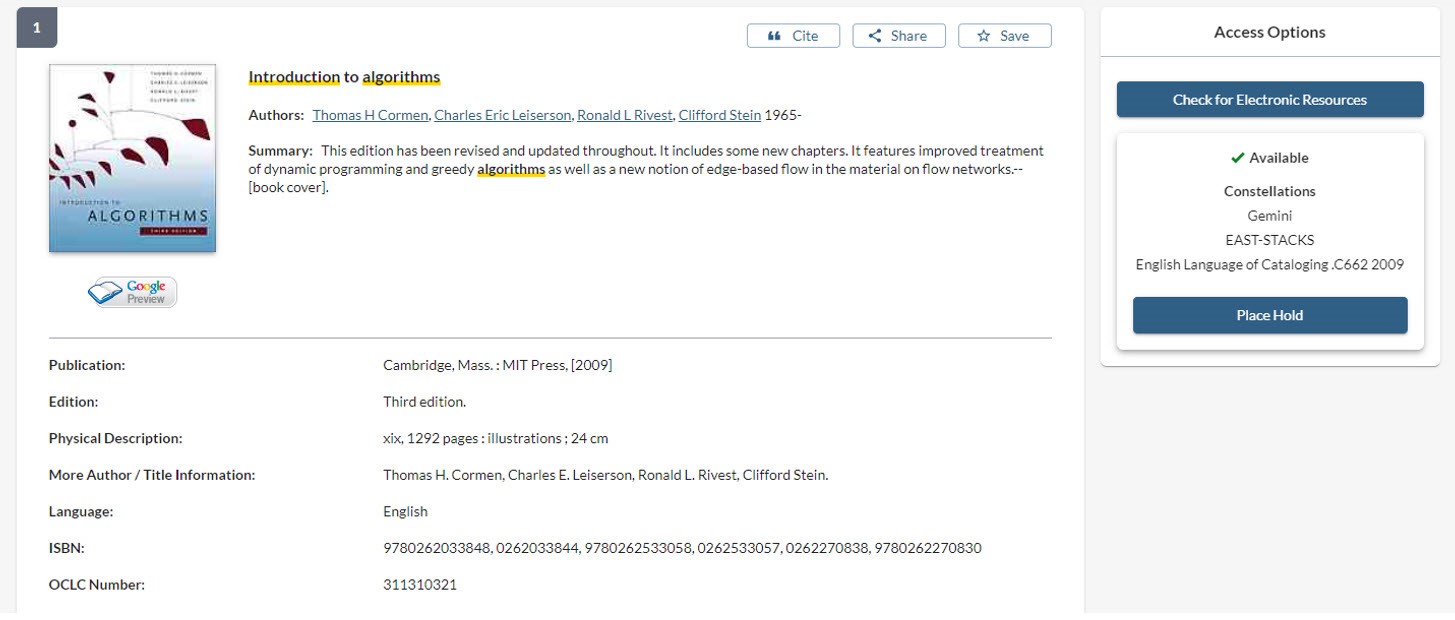
Physical fulfillment prioritization
The best access options feature will consider all fulfillment options for a record and select the option that is:
- Held, prioritizing your local holdings first, then group holdings, then libraries worldwide
- Available, determined by the presence of a local holding record or item record displayed via a Z39.50 connection or screen scrape
It will then look to display fulfillment options associated with items that are:
- Held, prioritizing your local holdings first, then group holdings, then libraries worldwide
- Unavailable, determined by the presence of a local holding record or item record displayed via a Z39.50 connection or screen scrape
Below are three common scenarios for an individual library:
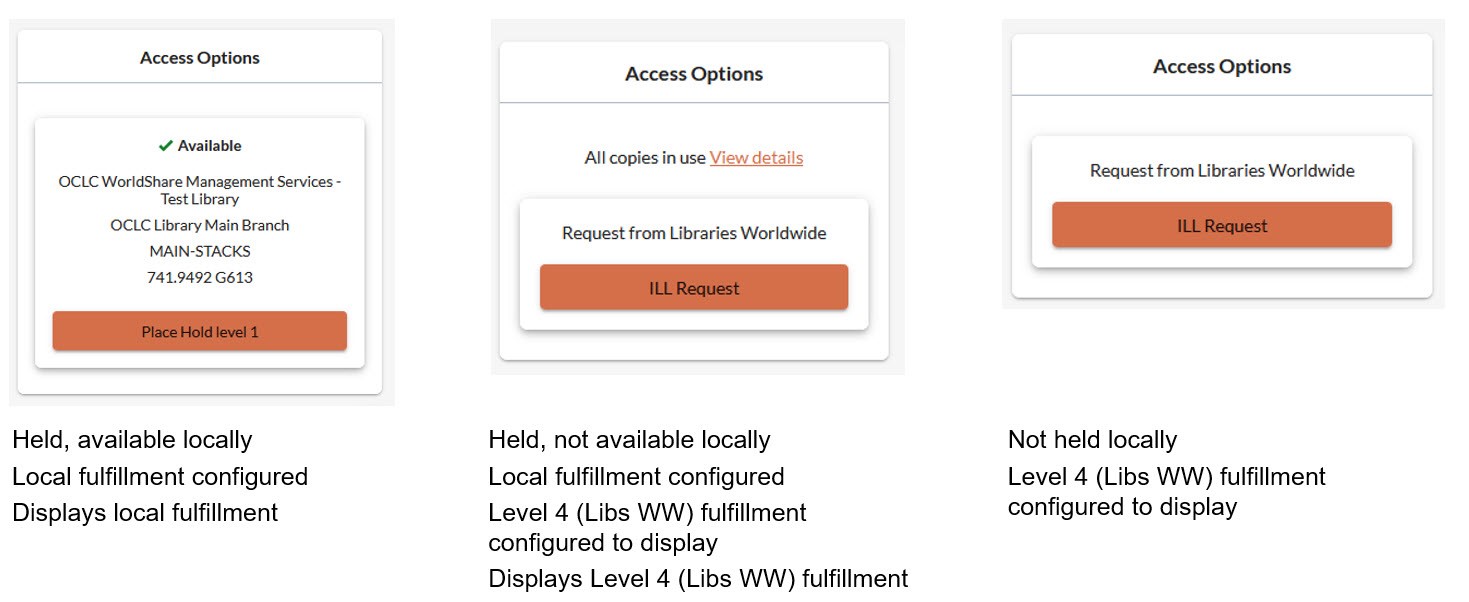
Below are three common scenarios for a library that is part of a WMS circulation group:
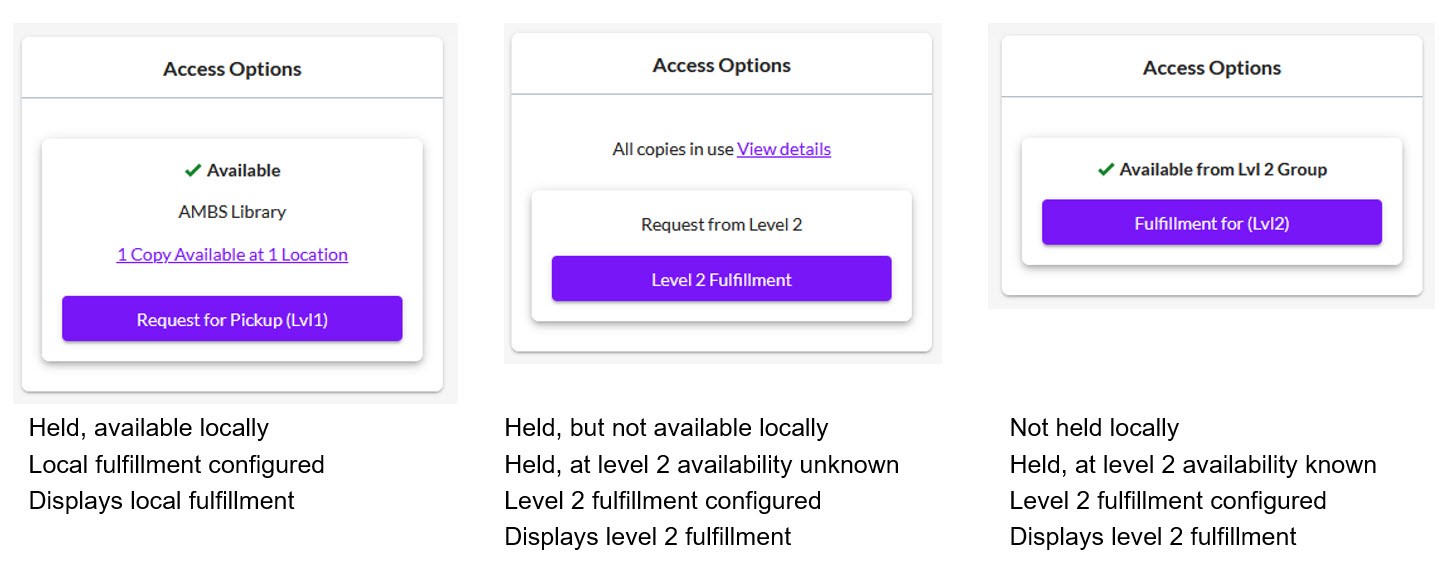
If no fulfillment option is configured for your library, your group, or libraries worldwide in your Place Hold and Request item module, only the holdings statement for the record will display.
WorldCat Discovery expert Danielle Bromelia provides a detailed introduction to the new best access options in the recording of a January 2021 presentation. Watch the recording.
If this feature does not work for your institution, and you want to disable it, please contact OCLC Support in your region.
Course Reserves actions are now available in the modernized WorldCat Discovery interface
Course reserves actions are now available in the modernized WorldCat Discovery interface. When logged into WorldCat Discovery with an account that has a Course Reserves role, you will now see a banner that indicates when you are in Course Reserves mode. The Reserve button will display directly beneath cover art on search results and on item details. The image below displays both the banner notification when in Course Reserve mode and the position of the Reserve button as it displays under the cover art.
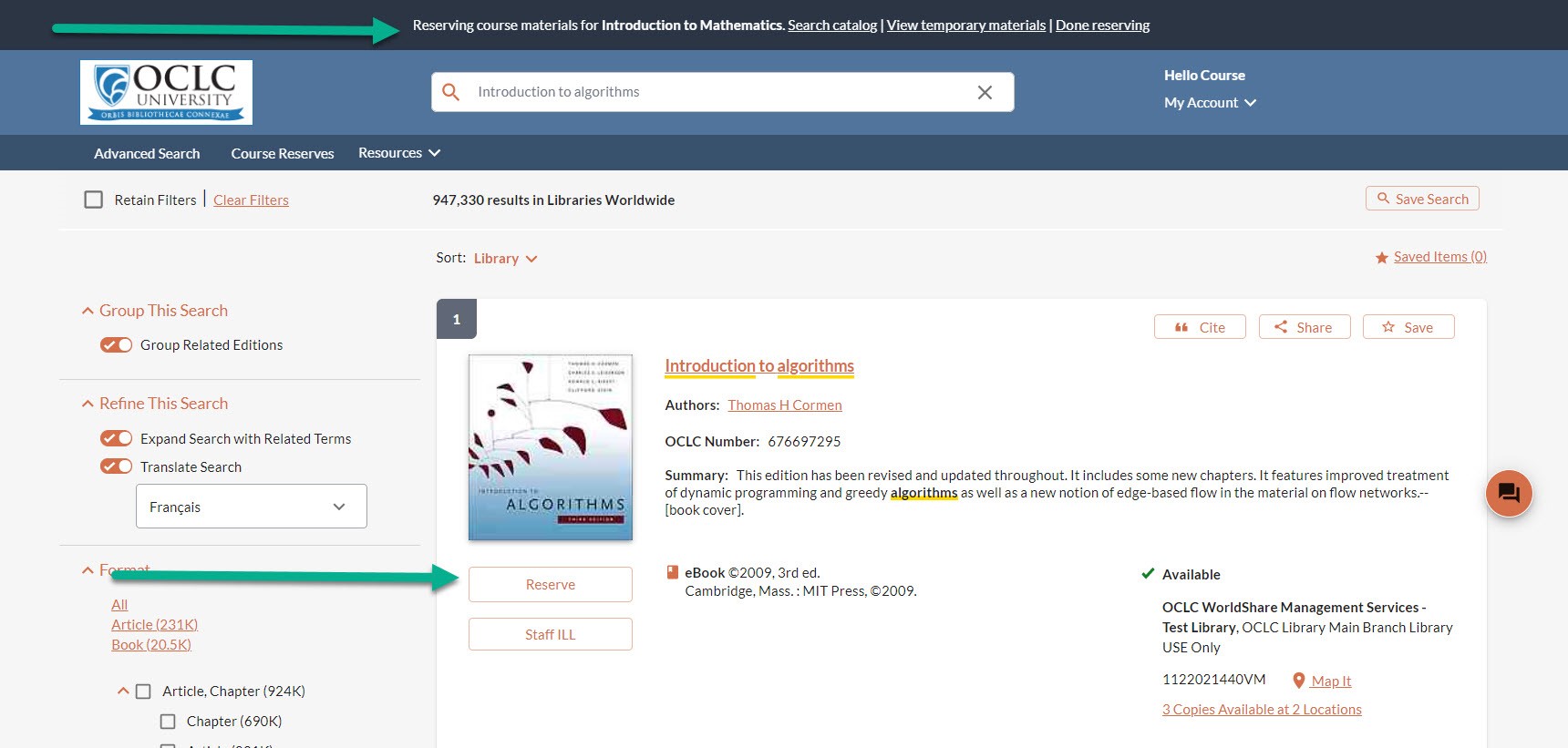
Workflow for reserving individual items
Selecting the Reserve action on search results or item details will display a message in the lower left corner of the screen indicating that the item has been added to the course, as in the following image:
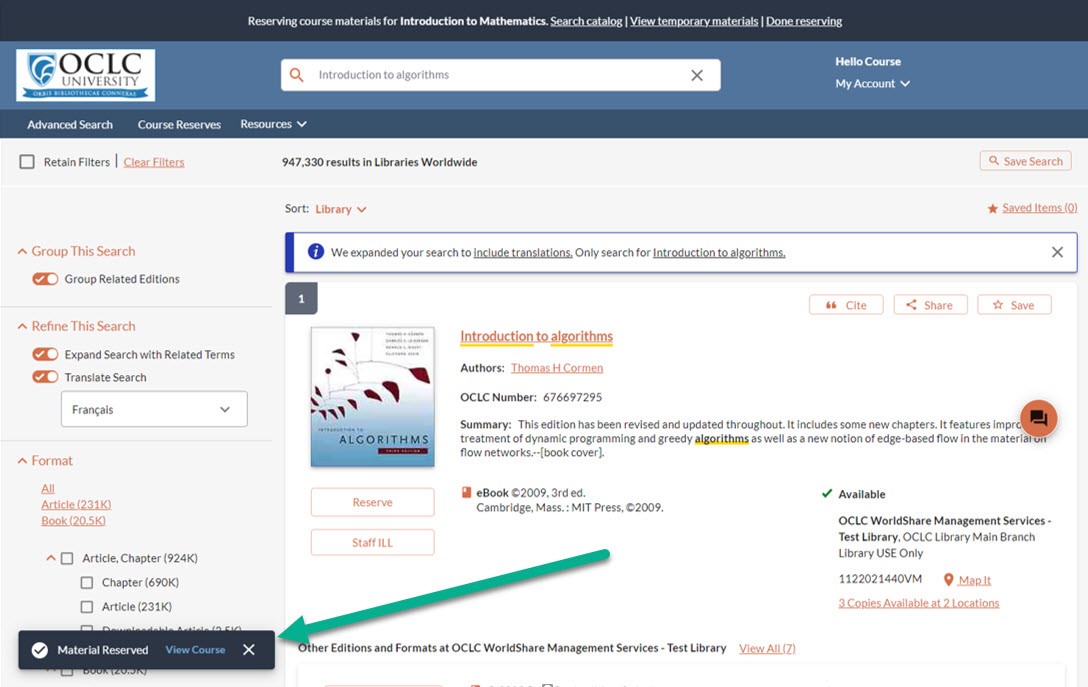
Reserving multiple items
Selecting the Reserve action on search results or item details for a record with multiple volumes will display a modal with a drop-down menu for you to reserve the available specific volumes, as in the following image:
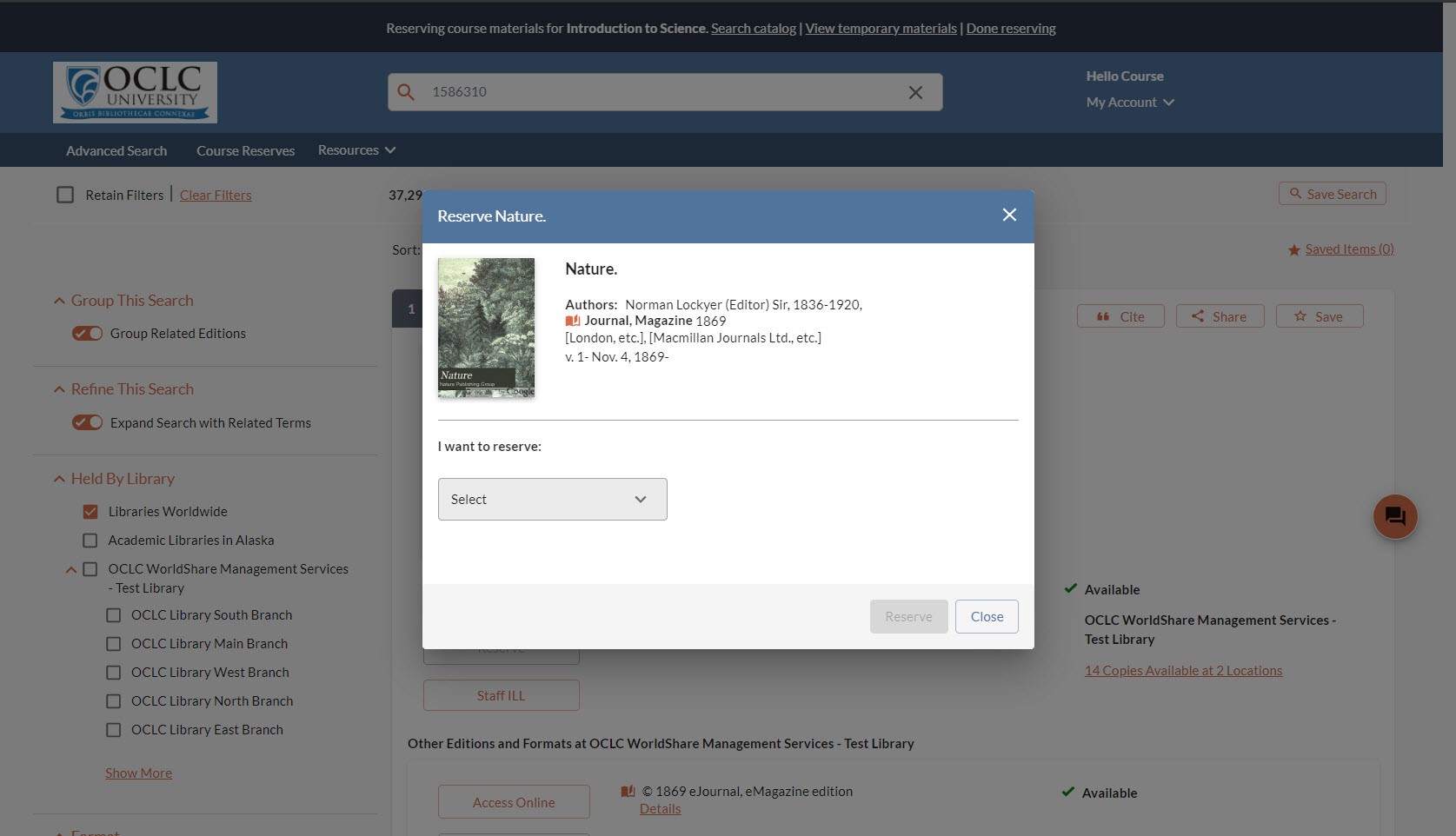
Remote databases will be displayed in a dismissible tray in the modernized user interface
Search results from remote databases not included in the WorldCat Discovery central index are now more visible with their repositioning from the filter column to a tray in the modernized WorldCat Discovery interface. When your default search is configured to include a remote database or a user selects a remote database from the Advanced Search screen, remote database results will now display at the bottom of the search results in a tray that expands and collapses. The image below illustrates the expanded view of this tray.
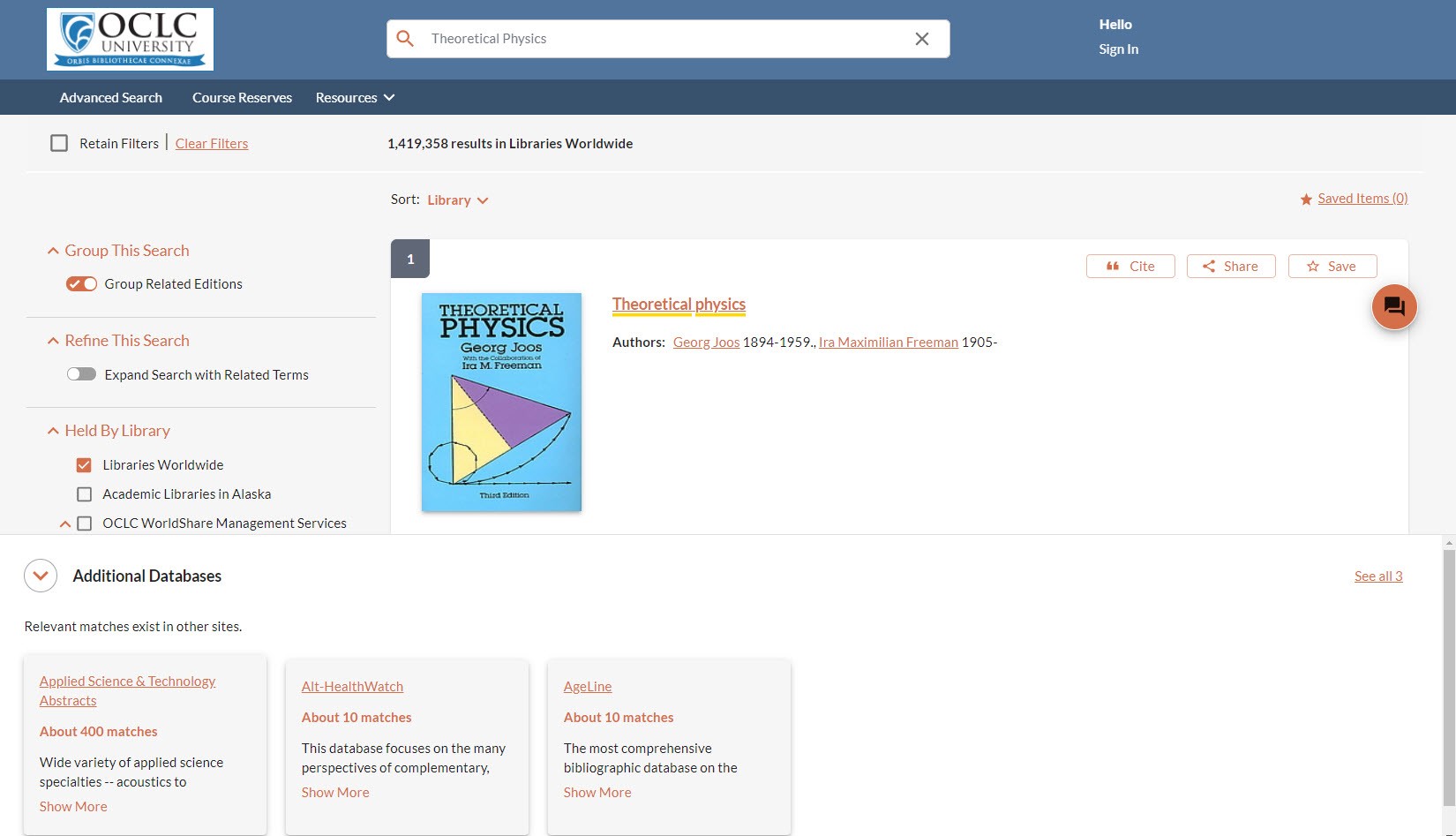
To minimize this tray, users can select the collapsible arrow. Remote database access will then display as a circular icon in the bottom right of WorldCat search results, available to be accessed at a later time, as in the image below:

StackMap call to action and modal now available in the modernized user interface
After the February release, StackMap functionality will be added to the modernized WorldCat Discovery interface. For libraries with StackMap integration activated via Service Configuration, the configured call to action (CTA), including “Map It”, “Locate” or “View Library Map”, will display on search results as well as the Access Options panel, local copies list and Browse the Shelf section of the item details page. When users click the CTA, a modal will open displaying the appropriate library map.
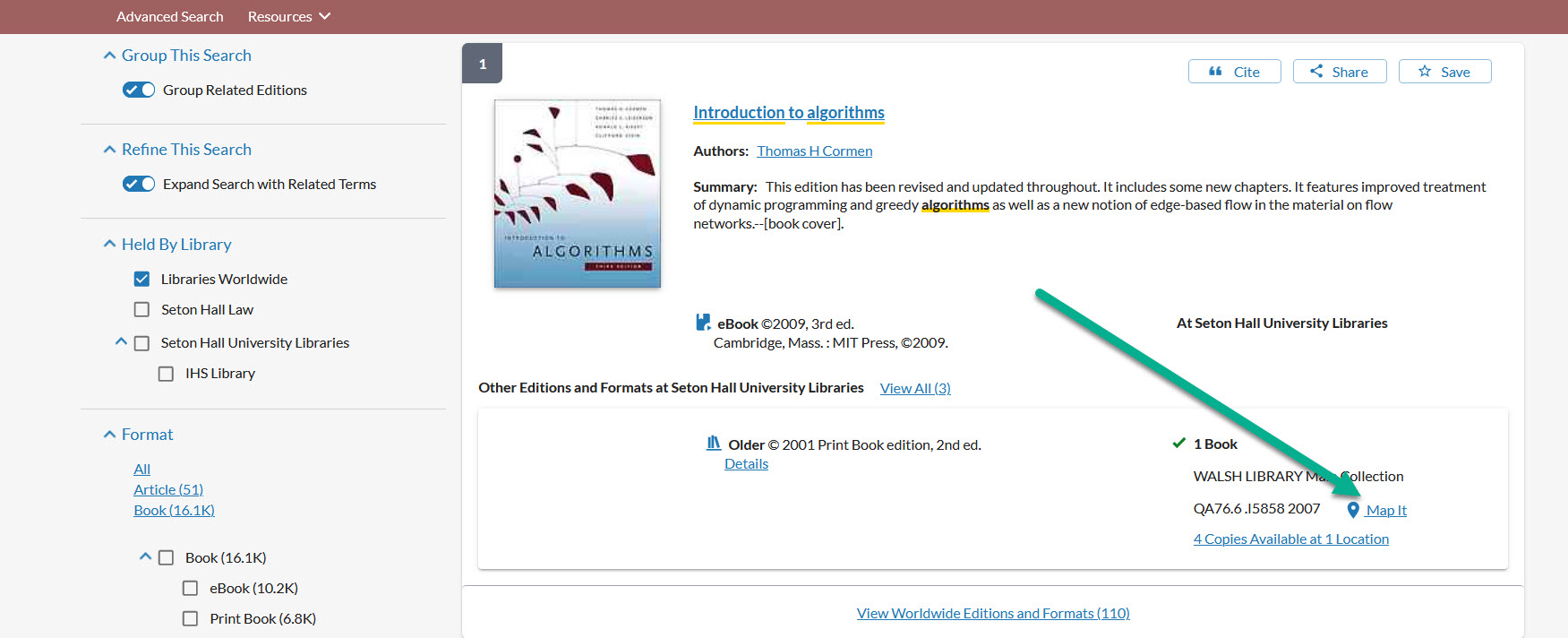
‘Map It’ call to action on search results
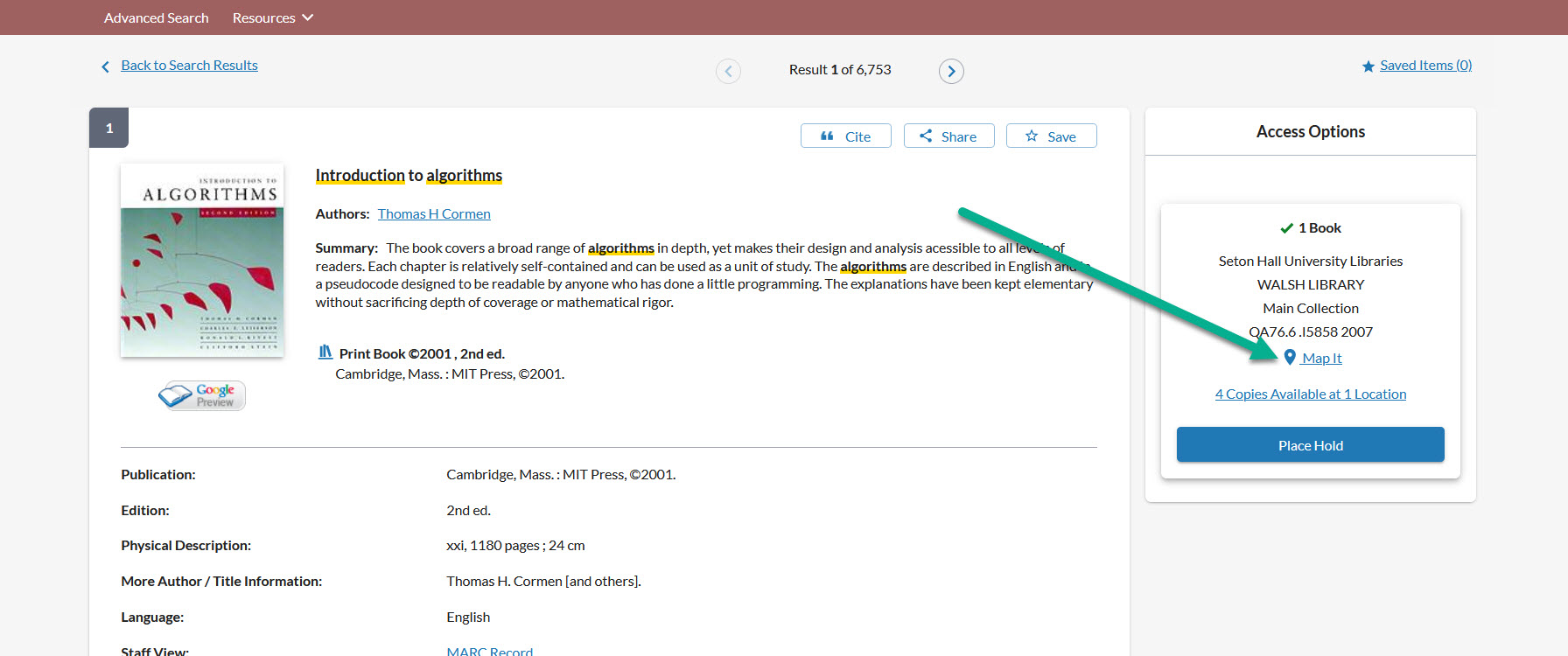
‘Map It’ call to action on the item details ‘Access Options’ panel
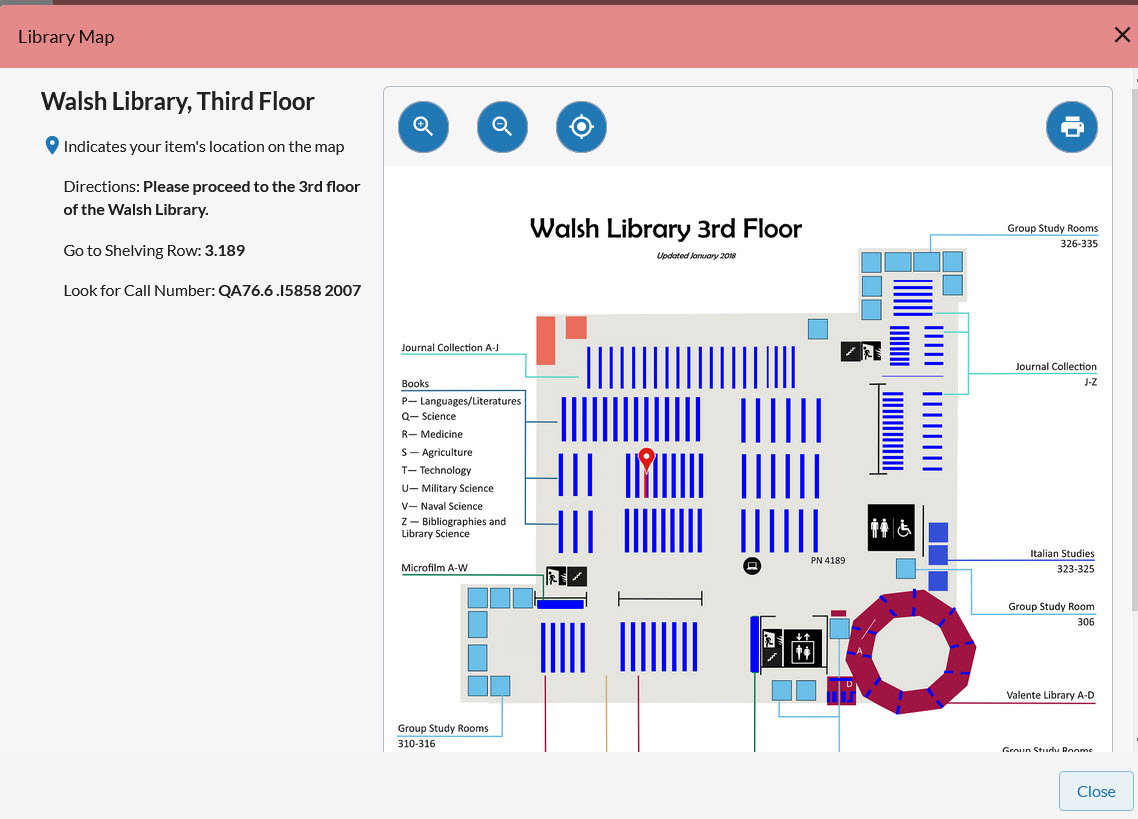
StackMap modal with zoom, center and print actions.
Improved description of holdings statement
After the February release users will see the holdings statement on brief results and the item details display “At <Your Library Name>" rather than Held by <Your Library Name> when the record is marked as held by your institution because the OCLC symbol has been attached to the bibliographic record but no item record or electronic fulfillment is available. This will help differentiate these records from those with fulfillment actions.
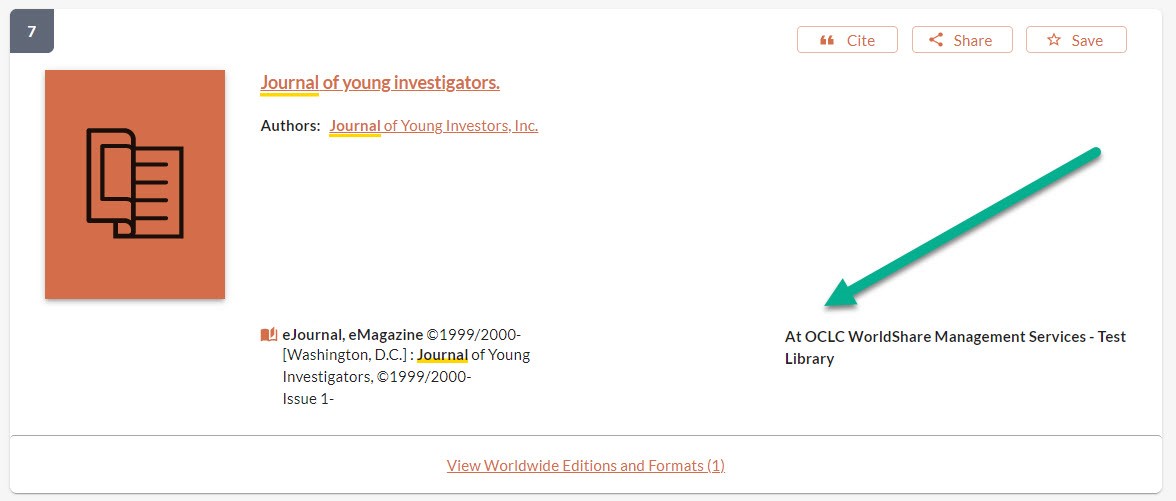
New content
This is a list of new databases added to WorldCat Discovery and WorldCat.org since our last update.
You can enable these databases as search options in the Licensed Content and Databases module of the OCLC Service Configuration site. Please remember that your library must have a valid subscription to these databases in order to enable them.
The complete list of databases is available here.
Available in WorldCat Discovery and WorldCat.org
- From Alexander Street
- The PBS Video Collection: Fourth Edition – All Titles An additional collection of PBS documentaries and series covering topics from science to history, art to Shakespeare, diversity to business & economics, and more.
- The World of Archie Comics Archive A digital collection offering access to the runs of publications from Archie Comics. Contains a variety of publication types, from comic book series to graphic novels, annuals, and one-shot comics.
- From Brill
- Supplements to The History of Afghanistan English translations of Nizhādnāmah-i Afghān (Afghan Genealogy) and Taẕakkur al-Inqilāb (Memoir of the Revolution), the culminating works of Fayż Muḥammad Kātib Hazārah’s monumental history of Afghanistan, Sirāj al-tawārīkh (The History of Afghanistan).
Available in WorldCat Discovery
- From Gale
- Political Extremism and Radicalism: Far-Right and Left Political Groups in the U.S., Europe, and Australia in the Twentieth Century Combines content on far-right and fascist movements, alongside significant coverage of radical left groups, allowing researchers to access material from both sides, and providing points for comparison.
Important links
Support website(s)
Support information for this product and related products can be found at:
Include Request ID with problem reports
When reporting an issue with WorldCat Discovery, it is extremely helpful to include the Request ID. The Request ID is found at the bottom of the screen on which the issue occurred. Including this information allows us to directly trace what happened on the request we are troubleshooting.

